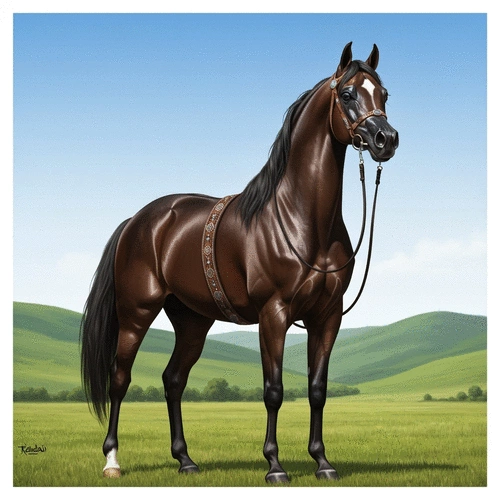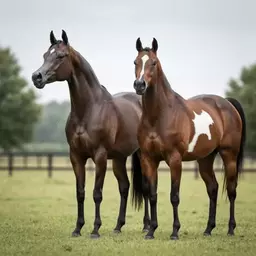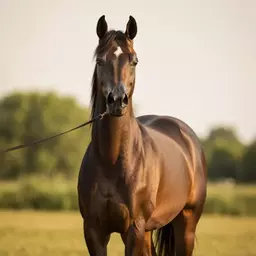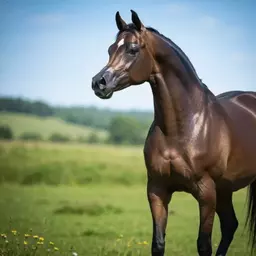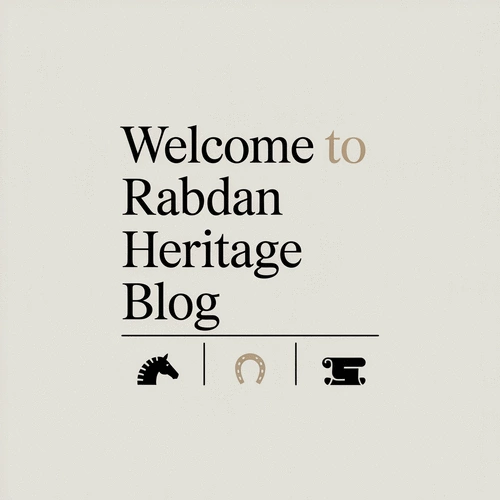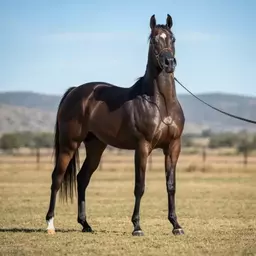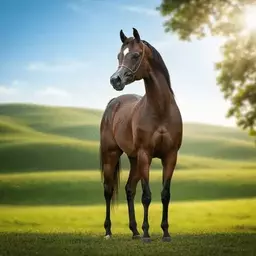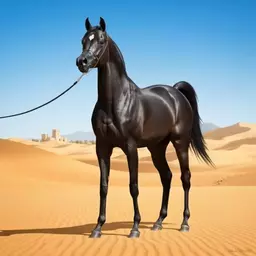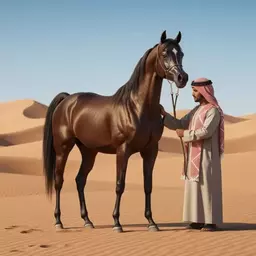As we delve into the illustrious lineage of the Rabdan Arabian horse, it’s worth considering how heritage influences not just the horse itself, but the very culture surrounding it. What can we learn from this remarkable bloodline that has captivated equestrians for centuries?
What You Will Learn
- The Rabdan Arabian horse bloodline is rooted in the rich traditions of the Arabian Peninsula, symbolizing strength and beauty.
- Ibn Rabdan's meticulous breeding practices laid the groundwork for the enduring legacy of the Rabdan bloodline.
- The Rabdan lineage is interconnected with other well-known Arabian bloodlines like Kuhaylah and Ajman, enriching its genetic diversity.
- Distinctive traits such as endurance, elegance, and specific conformation characteristics define the appeal of Rabdan Arabian horses.
- Color variations among Rabdan horses, including bay, grey, and chestnut, reflect their lineage and have genetic implications for breeding choices.
- Community engagement and ethical breeding practices are essential for preserving the legacy of the Rabdan Arabian horse.
- Arabian horse associations play a vital role in promoting the Rabdan heritage through educational initiatives and competitions.
The Rabdan Arabian Horse: Key Connections and Characteristics
Delve into the genetic heritage and distinguishing features of the Rabdan Arabian horse, showcasing its significant links to other esteemed bloodlines and its unique physical traits.
Connections to Other Arabian Horse Origins
Kuhaylah: Known for endurance and strong conformation.
Ajman: Famous for elegant appearance and versatility.
Other Strains: Played roles in shaping Rabdan lineage, emphasizing interconnectedness.
Understanding these links deepens appreciation for Rabdan's heritage.
Common Colors & Genetic Implications
Bay: A classic color, known for its beauty.
Grey: Evolves over time, highly desirable.
Chestnut: Rarer in Rabdan strain, unique allure.
Colors offer insights into lineage and breeding choices.
Conformation Traits in Rabdan Horses
Well-defined neck: Elegance and balanced movement.
Strong back: Crucial for performance and soundness.
Refined head: A hallmark of Arabian beauty.
Critical for performance, aesthetics, and breeding success.
Genetic Inheritance Patterns
Consistent traits: Strength, elegance, and endurance across generations.
Traceable patterns: Reveals blends of key characteristics.
Breeder focus: Ensuring quality and integrity of the bloodline.
Key to preserving the integrity and quality of this storied lineage.
A Deep Dive Into the Rabdan Arabian Horse Bloodline
Welcome to our in-depth exploration of the Rabdan Arabian horse bloodline! This journey will take us through the rich history, distinctive traits, and the lasting impact of this remarkable lineage. As an equestrian and historian, I have always been fascinated by the Rabdan bloodline and its profound significance in the world of Arabian horses. Let’s get started!
Understanding the Origins of the Rabdan Arabian Horse
Exploring the Historical Roots of the Rabdan Bloodline
The Rabdan bloodline has its roots deeply embedded in the ancient traditions of the Arabian Peninsula. This lineage is not merely a family tree; it embodies centuries of culture and history that have shaped the Arabian horse community. Did you know that the Rabdan bloodline is often considered one of the most prestigious among Arabian horse breeds?
Tracing back to its origins, we see that these horses have historically been revered by Bedouin tribes, who recognized their strength and beauty. It’s fascinating to think about the stories these horses have witnessed over the centuries! The genetic history of Arabian horses, including the Rabdan strain, has been a subject of scientific interest, with studies like those published in PubMed providing insights into their unique genetic makeup.
The Significance of Ibn Rabdan in Arabian Horse History
Ibn Rabdan is a name that resonates deeply within Arabian horse lore. He was a legendary figure known for his meticulous breeding practices that prioritized both performance and temperament. His methods laid the groundwork for what we now recognize as the Rabdan bloodline.
Through Ibn Rabdan’s dedication, a lineage was established that not only preserved the physical traits of the Arabian horse but also its character. This enduring legacy continues to influence breeders and enthusiasts today!
Connections Between Rabdan and Other Arabian Horse Origins
The Rabdan Arabian horse is often linked to several prominent bloodlines across the globe. Understanding these connections can help us appreciate the broader context of Arabian horse history. For instance, the Rabdan lineage shares a significant connection with the Kuhaylah and Ajman strains, each contributing unique qualities to the Arabian breed.
- Kuhaylah: Known for its endurance and strong conformation.
- Ajman: Famous for its elegant appearance and versatility in various equestrian disciplines.
- Other Historical Strains: Many other strains have played a role in shaping the Rabdan lineage, emphasizing the interconnectedness of Arabian horses.
By exploring these connections, we can gain a deeper understanding of the heritage and cultural significance of the Rabdan Arabian horse! Research from institutions like Cornell University has further clarified the genetic relationships and historical beliefs surrounding various Arabian horse strains, including those linked to Rabdan.
Key Characteristics of the Rabdan Arabian Horses
Distinctive Traits and Genetic Inheritance Patterns
One of the defining aspects of the Rabdan Arabian horse is its genetic inheritance. These horses possess remarkable traits that are largely consistent across generations, making them highly sought after by breeders. The genetic patterns can be traced, revealing a fascinating blend of strength, elegance, and endurance.
Understanding these traits is essential for anyone involved in breeding or caring for Rabdan horses. It’s about more than just lineage; it’s about ensuring the quality and integrity of this storied bloodline! Further genetic analysis, as highlighted in articles on PMC NCBI, continues to uncover the intricate inheritance patterns that define Arabian horse breeds.
Common Colors and Their Genetic Implications
The diversity in colors among Rabdan Arabian horses is another captivating aspect to consider. From rich bay to striking grey, each color carries its own genetic implications. These color variations often reflect the horse's lineage and can offer insights into breeding choices.
- Bay: A classic color, known for its beauty and brilliance.
- Grey: A color that evolves over time, often considered highly desirable.
- Chestnut: A rarer color in the Rabdan strain, adding to its unique allure.
Each color tells a story, providing a glimpse into the horse's heritage and the care taken in its breeding!
Understanding Arabian Horse Conformation in Rabdan Horses
Conformation is a critical aspect of the Rabdan Arabian horse’s appeal. Their physical structure not only impacts performance but also influences their aesthetic beauty. Breeders often look for specific traits such as a well-defined neck, strong back, and a refined head.
Recognizing these conformation traits can elevate a horse's status in competitions and breeding programs. It’s exciting to see how these characteristics can be a testament to the horse’s lineage and breeding practices!
Pro Tip
Did you know? When breeding Rabdan Arabian horses, it's crucial to not only focus on their lineage but also to observe their individual temperaments. A horse's personality can significantly impact its performance and compatibility in various disciplines. By prioritizing both genetic traits and behavioral qualities, you can ensure a well-rounded and exceptional equine partner!
Frequently Asked Questions About the Rabdan Arabian Horse
What is the Rabdan Arabian horse bloodline known for?
The Rabdan Arabian horse bloodline is celebrated for its deep historical roots in the Arabian Peninsula, symbolizing strength, beauty, endurance, and elegant conformation. It is considered one of the most prestigious Arabian horse breeds.
Who was Ibn Rabdan and what was his contribution to the bloodline?
Ibn Rabdan was a legendary figure in Arabian horse lore, known for his meticulous breeding practices. He laid the groundwork for the Rabdan bloodline by focusing on both performance and temperament, ensuring the preservation of both physical traits and character.
How is the Rabdan lineage connected to other Arabian horse strains?
The Rabdan lineage is significantly connected to other prominent Arabian horse strains such as Kuhaylah, known for endurance, and Ajman, famous for elegance and versatility. These connections highlight the interconnected genetic heritage of Arabian horses.
What are the distinctive physical traits of Rabdan Arabian horses?
Rabdan Arabian horses are characterized by distinctive traits such as a well-defined neck, a strong back, and a refined head. These conformation traits are crucial for their performance, aesthetic appeal, and success in breeding programs.
What are the common color variations in Rabdan horses and their genetic implications?
Common colors include bay, grey, and chestnut. Bay is a classic and brilliant color, grey evolves over time and is highly desirable, while chestnut is rarer and adds uniqueness. These color variations reflect the horse's lineage and provide insights for breeding choices.
What role do Arabian horse associations play in preserving the Rabdan heritage?
Arabian horse associations are pivotal in preserving the Rabdan heritage by hosting educational seminars, organizing competitions emphasizing Rabdan traits, and providing platforms for research and historical findings. They foster a community that values and celebrates the bloodline.
Summarizing the Importance of the Rabdan Arabian Horse Bloodline
As we reflect on the rich history and cultural significance of the Rabdan Arabian horse, it becomes clear that this bloodline is not just a lineage; it is a profound legacy that connects us to our past while shaping the future of Arabian horses. The Rabdan strain embodies the spirit, strength, and beauty of its ancestors, and it is our duty as enthusiasts and breeders to ensure its preservation for generations to come!
At Rabdan Heritage Blog, I believe that the future of this noble bloodline relies on our active participation in its conservation and celebration. Both breeders and enthusiasts play a crucial role in maintaining the unique traits that define the Rabdan Arabian horse.
The Cultural Significance and Future of the Rabdan Strain
The Rabdan Arabian horse holds a special place in the hearts of many, serving as a symbol of heritage and pride. Preserving this legacy requires collective action—what can we do to ensure its continuity?
- Participate in community events and discussions about breeding.
- Support organizations that promote Arabian horse culture.
- Document and share your experiences with Rabdan horses to inspire others.
Each of these actions helps foster a community that values the Rabdan strain. Moreover, organizations and associations dedicated to Arabian horses can play a substantial role in this preservation effort.
Preserving the Legacy: Actions for Breeders and Enthusiasts
As breeders and enthusiasts, we can take concrete steps to protect the Rabdan bloodline. This includes:
- Implementing ethical breeding practices that emphasize health and temperament.
- Engaging in educational initiatives to share knowledge about the Rabdan strain.
- Participating in exhibitions and competitions that highlight the beauty and abilities of Rabdan Arabian horses.
By committing to these actions, we contribute to the ongoing legacy of the Rabdan Arabian horse, ensuring that its story continues to be told.
The Role of Arabian Horse Associations in Promoting Rabdan Heritage
Arabian horse associations are pivotal in promoting the heritage of the Rabdan bloodline. These organizations work diligently to create events, resources, and networking opportunities that celebrate our beloved breed. For instance:
- Hosting educational seminars on breeding best practices.
- Offering competitions that emphasize Rabdan traits.
- Providing platforms for sharing research and historical findings on the bloodline.
By participating in these associations, we not only gain valuable insights but also help to keep the conversation around Rabdan horses alive and thriving!
Practical Tips for Breeding and Recognizing Rabdan Traits
If you're passionate about breeding Rabdan Arabian horses, it's essential to recognize the unique traits that define this bloodline. Here are a few tips to keep in mind:
- Study the pedigree and lineage carefully to identify key characteristics.
- Observe and note physical traits that are distinctive to the Rabdan strain.
- Engage with other breeders to learn about their experiences and insights.
These strategies can enhance your breeding program and ensure that you uphold the integrity of the Rabdan heritage.
Strategies for Engaging with the Community and Resources
Building connections within the Arabian horse community enriches our understanding and appreciation of the Rabdan bloodline. Here’s how to engage effectively:
- Join online forums and social media groups focused on Arabian horses.
- Attend horse shows and exhibitions to meet other passionate breeders.
- Share your own experiences and stories related to Rabdan horses.
By doing so, we create an enriching environment where knowledge flows freely and everyone's passion for Arabian horses can flourish!
Essential Care and Training Techniques for Rabdan Arabian Horses
Finally, caring for and training your Rabdan Arabian horses requires special attention to their needs. Here are a few essential techniques to consider:
- Establish a regular grooming routine to maintain their beautiful coats.
- Provide a balanced diet tailored to their nutritional needs.
- Implement consistent training methods that respect their intelligence and sensitivity.
With these strategies, we can help our Rabdan Arabian horses thrive, ensuring they not only excel in competitions but also embody the spirit of their noble heritage!
Recap of Key Points
Here is a quick recap of the important points discussed in the article:
- The Rabdan Arabian horse bloodline has deep historical roots, revered for its strength and beauty.
- Ibn Rabdan’s breeding practices have significantly influenced the lineage, preserving both physical traits and temperament.
- Common colors like bay, grey, and chestnut each carry unique genetic implications and stories of heritage.
- Conformation is vital for performance and aesthetic appeal in Rabdan horses; key traits include a well-defined neck and strong back.
- Engagement in community events and support for Arabian horse culture is crucial for preserving the Rabdan bloodline.
- Implementing ethical breeding practices and participating in educational initiatives can enhance the legacy of the Rabdan Arabian horse.

